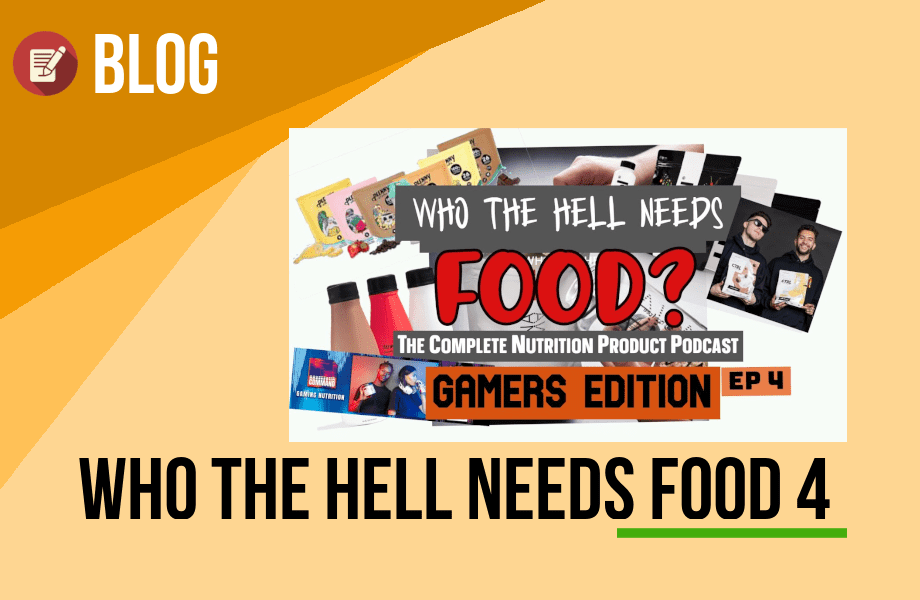Who the Hell Needs Food Ep 4 | Are Gaming meal Shakes Good?
Once again, Clive and I had an interesting chat about Complete Foods in our podcast; “Who the Hell Needs Food?”. Among the many topics, this time we focused on gaming meal replacements or rather, meal replacements focused on gamers.
It was a topic that Clive had recently discovered with Team Command (UK) releasing a brand new product for gamers. While they previously offered nootropics (gaming energy drinks), this was a step that took us both by surprise.
On this site, we have previously covered CTRL Drink, a US based meal replacement company made by gamers for gamers and we were pretty critical about it.
Either way, on this latest episode, we covered this and many other topics that you might find interesting, so please check it out:
Gaming Meal Replacements
Targeting meal replacements to gamers is no novel concept. Back in the day, Soylent dabbled with the gamers and streamers, as it seem a logical target audience.
Gamers are notorious for few things, including, being lazy and not eating healthily. Thus, they tend not to eat often or/and order take-aways. Therefore meal replacements are the ideal solution for them, since they can eat in front of the computer without having to stop playing.
In a similar fashion, the initial consumer of complete foods was on average male, between 24-40 and had an IT related job. Hence, companies were eager to sell the products to this demographic.
No One Had Succeeded
However, all OG companies failed to attract these customers. Soylent couldn’t do it, Jimmyjoy couldn’t do it and even now Huel cannot do it.
Why is this?
In my opinion the answer is “simple”. They brands were just too generic and not cool enough. One thing that it’s important to understand is that gamers are notoriously bad customers. It’s hard to convert them.
Furthermore, they are used to a very particular aesthetic and brand feel. The RGBs, the black websites, the colours… In fact, such is the admiration for gaming style, that brands have been making tons of money by making standard products, “gaming products”.
Gaming chairs, gaming glasses, gaming keyboards, gaming monitors, gaming energy drinks (one of the latest trends)… The list goes on and on. 90% of the time, these are standard products with different aesthetics.
New Wave
So few people, including one of the co-founders of FaZe Clan (famous e-sport org) decided to create a Complete Food just for gamers. Here starts CTRL Drink.

From the get go you can tell something is different. The naming. It’s not a generic brand name, but it’s gaming related. When you go on the site, you will see that the visuals are different, the flavours of the shakes are different, the people on it are more cool and even the messaging is different.
Ding, ding ding. Profit.
You have now unlocked the key to success. Focus solely on them, and give them a platform on which are comfortable. Now, add a little bit of influencer marketing… and voila! Success.
As the old meme used to be:
- Take an old product/idea.
- Rebrand it to gaming. Make everything gaming related.
- Influencer marketing.
- ???
- Profit.
So, Are these Meal Replacements Good?
Ultimately, are these healthy? Well.. that is relative. They are definitely healthier than your average burger, pizza, subway, sugary cereal or alternative that gamers might consume.
However, from a complete food enthusiast, these are bottom of the barrel meal replacement. Down there with Slimfast, Atkins and the rest. Usually they contain high amounts of sugars, and/or tons of processed ingredients. They will lack key nutrients (like omega-3) and their focus will be on the taste, rather than the nutritional output.
Like I said for the CTRL Drink review: “Great from the outside, crap from the inside”.
Conclusion
At the end of the day is not as simple as saying, they are not as healthy as normal meal replacements; since, many of the “top” manufacturers have tried and failed to reach this demographic.
In recent days, there’s been a little bit more effort from Huel (partnering with Twitch streamers and other influencers), YFood (which does reasonably well with the German audience), to name a few. However, when converting this audience is where problems arise.
This companies do not have a “gamer friendly” interface. In short, they don’t speak the same language, so it’s normal that gamers won’t buy from them.
Thus, taking advantage of this failure in communication, these companies might thrive. Ultimately, I hope that they can use it as a stepping stone. Get familiarized with the concept and move on to healthier shakes as they grow older.
Remember to check out this discussion and more in the “Who the Hell Needs Food?” podcast.


